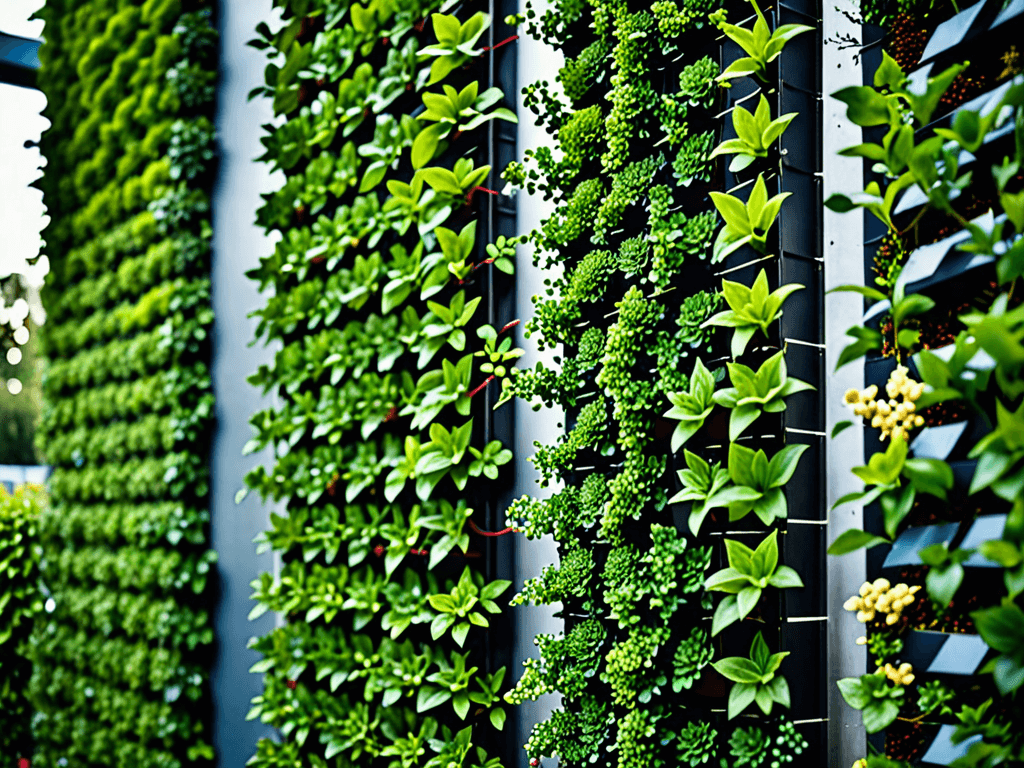Vertical gardening can transform spaces, particularly in urban environments. It provides a sustainable and pleasing way to incorporate nature into our lives.
The concept and benefits of vertical gardening.
Vertical gardening is a creative method of growing plants on vertically suspended panels or in other upright containers. This innovative technique maximizes space, making it ideal for urban environments where space is often at a premium. One of the primary benefits of vertical gardening is its ability to transform small areas into lush, green spaces that can improve air quality and enhance aesthetics.
Additionally, vertical gardens can contribute to sustainability. They can reduce the urban heat island effect, as the plants provide a cooling effect, and they can be used to grow food in limited spaces, thus promoting local food production. Furthermore, vertical gardens can increase biodiversity by offering a habitat for various insects and birds.
With the growing trend of eco-friendly living, vertical gardening also appeals to those looking to reduce their carbon footprint. By utilizing recycled materials to create frames and supports, gardeners can make their green spaces even more sustainable. The vertical aspect allows for easy access to plants for both maintenance and harvesting, which can encourage more people to pursue gardening as a hobby or a sustainable lifestyle practice.
Whether you’re an experienced gardener looking to try something new or a beginner with limited space, vertical gardening offers a range of possibilities that can cater to various needs and preferences.
Choosing suitable plants.
When it comes to vertical gardening, choosing suitable plants is crucial for ensuring success. Not all plants thrive in vertical environments, so it’s important to select ones that can adapt to the unique growing conditions.
Climbing plants such as ivy, morning glory, and honeysuckle are excellent choices because they naturally grow upwards and can cover the structure beautifully.
Herbs like basil, thyme, and oregano are also popular in vertical gardens. They are compact, easy to maintain, and can provide fresh flavors for your kitchen.
Additionally, consider using succulents like sedum or echeveria; their ability to store water and thrive in varied light conditions makes them perfect for minimizing maintenance.
Another factor to consider is the sunlight requirements of your chosen plants. Plants that require similar light conditions should be grouped together to ensure uniform care.
For instance, shade-loving plants such as ferns or hostas can be placed in lower sections, while sun-loving varieties like tomatoes or strawberries can occupy the top levels.
Selecting the right plants based on their natural growing tendencies and environmental needs will help you create a thriving vertical garden that flourishes over time.
Necessary tools and materials.
Setting up a vertical garden requires specific tools and materials to ensure a stable and thriving environment for your plants. First and foremost, you’ll need a sturdy frame or structure to support the weight of the plants and soil. This could be a wooden pallet, a prefabricated panel, or even a DIY solution using wire or mesh. If you’re looking to create a visually appealing display, consider using materials that complement your outdoor or indoor decor.
Next, choose quality containers or pockets for planting. Fabric pockets or plastic containers work well because they hold soil effectively while allowing for drainage. Make sure each container has proper drainage to prevent overwatering, which can be detrimental to the plant’s health.
Soil selection is another crucial aspect. Use a lightweight, nutrient-rich potting mix that aids in moisture retention yet remains airy enough for roots to breathe. Additionally, a slow-release fertilizer can be mixed into the soil to provide ongoing nutrients as plants grow.
To maintain your vertical garden, basic gardening tools like pruning shears, a watering can, or a drip irrigation system for consistent watering are essential. Depending on your setup, you might also need cable ties, hooks, or brackets for secure installation. With the right tools and materials, creating a successful vertical garden can be both a rewarding and enjoyable project.
Step-by-step instructions for setup.
Creating a vertical garden involves several steps to ensure your plants thrive. Begin by choosing the location, considering factors like sunlight and accessibility.
Once you’ve selected the spot, install the frame or structure securely, using screws or brackets for reinforcement. Double-check that your frame can support the weight of wet soil and growing plants.
Next, prepare the containers or pockets for planting. If you are using fabric pockets, attach them to the structure with heavy-duty staples or screws. For pots, place them in a manner that ensures even distribution and stability. Fill each with a high-quality potting mix, leaving some space at the top.
After preparing the containers, start planting the chosen plants. Consider the plant arrangement, placing taller plants on top and trailing ones at the bottom for a cascading effect. Gently remove seedlings from their nursery pots and position them in the new containers, covering roots well with soil.
Once planting is complete, water the vertical garden thoroughly, making sure water reaches all levels. For maintenance, set up a drip irrigation system if possible or water manually as needed.
Maintenance tips.
Proper maintenance is key to a thriving vertical garden. Regular watering is crucial, but it’s important to ensure that all plants receive adequate moisture. Check the soil moisture levels regularly and adjust the watering schedule to prevent overwatering or underwatering.
Using a drip irrigation system can help maintain consistent moisture levels.
Pruning is necessary to manage plant growth and encourage bushier, healthier plants. Remove any damaged or yellowing leaves to keep the garden looking tidy and to prevent the spread of disease. Regular pruning also allows more light to reach the plants, promoting growth.
Fertilize the plants periodically to replenish nutrients in the soil. A slow-release fertilizer is ideal for vertical gardens, as it provides nutrients over an extended period. Ensure that you use fertilizer appropriate for the types of plants in your garden.
Monitor for pests and diseases frequently. Inspect plants for signs of trouble such as wilting, spots, or unusual growths. Early detection allows you to manage issues before they spread. Natural remedies and organic pest control methods can be effective in keeping your garden healthy and pest-free.
Handling common challenges.
Vertical gardens can face various challenges that require attention. One common issue is water management. Ensuring that water reaches all plants evenly can be difficult, so installing an effective irrigation system or manually checking moisture levels can help prevent dryness or waterlogging.
Another challenge is maintaining the structural integrity of the garden. Over time, the frames and containers may weaken due to weather conditions or the weight of growing plants. Regularly check for wear and reinforce as needed to keep the structure intact and safe for plants.
Pests and diseases can also pose problems in vertical gardens. Use organic pesticides or natural remedies where possible to eliminate pests and prevent plant diseases. Regular monitoring can aid in early detection and control before issues become widespread.
Light availability can be inconsistent, especially in urban settings where buildings may obstruct sunlight. Consider using grow lights or reflective materials to enhance light access and ensure plant health.
Creative ideas for vertical gardening.
Vertical gardening offers a chance to express creativity in unique ways. Utilize recycled materials like old pallets, pipes, or buckets to craft distinctive plant displays. This not only saves money but also gives your garden a rustic charm.
Consider mixing different plant types for varied textures and colors. Combining flowering plants with leafy greens creates a dynamic effect. Using succulents and cacti alongside herbs can provide a striking visual contrast.
Integrating vertical planters into unexpected spaces can surprise and delight. Use walls, fences, or even small balcony railings for your garden. For an extra touch, add decorative elements like painted panels or artistic pots to make your garden area a true reflection of your personal style.
Incorporate lighting for a magical evening look. String lights or LED plant lights can enhance nighttime visibility while creating an alluring atmosphere. With imagination, vertical gardening can transform even the smallest spaces into living works of art.
Embracing the Benefits of Vertical Gardening
Vertical gardening offers a wide range of advantages, from maximizing space in urban settings to enhancing the aesthetic appeal of any environment.
By careful selection of plants and materials, these gardens can thrive even in small or unconventional spaces.
Maintenance involves regular watering, pruning, and monitoring for pests, but these tasks are outweighed by the joy and benefits a vertical garden can provide.
Not only do they contribute to a greener planet, but they also offer the satisfaction of growing your own plants.
With creative approaches and understanding common challenges, you can create a stunning vertical garden that elevates your living or working spaces.
So, explore the possibilities and let your imagination transform walls into vibrant, living art.
FAQ – Frequently Asked Questions about Vertical Gardening
What are the benefits of vertical gardening?
Vertical gardening maximizes space, improves air quality, and adds aesthetic appeal to any area.
Which plants are best for vertical gardens?
Plants like ferns, succulents, herbs, and climbing vines such as ivy or jasmine are excellent choices.
How do I ensure proper irrigation in a vertical garden?
Consider using a drip irrigation system or regularly check moisture levels to avoid under or over watering.
What materials can I use for building a vertical garden?
You can use recycled materials like pallets, PVC pipes, and fabric pockets or purchase prefab kits.
How do I handle common pests in vertical gardens?
Regularly inspect your plants and use organic remedies like neem oil or insecticidal soap.
Can vertical gardens be installed indoors?
Yes, vertical gardens can thrive indoors with proper light and humidity control.


